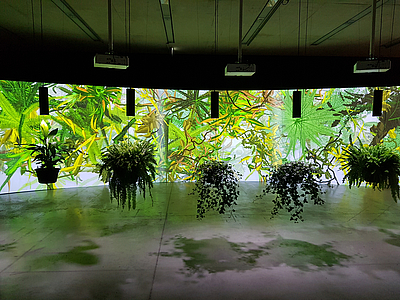Welcome at the Interface Culture program website.
Acting as creative artists and researchers, students learn how to advance the state of the art of current interface technologies and applications. Through interdisciplinary research and team work, they also develop new aspects of interface design including its cultural and social applications. The themes elaborated under the Master's programme in relation to interactive technologies include Interactive Environments, Interactive Art, Ubiquitous Computing, game design, VR and MR environments, Sound Art, Media Art, Web-Art, Software Art, HCI research and interaction design.

The Interface Culture program at the Linz University of Arts Department of Media was founded in 2004 by Christa Sommerer and Laurent Mignonneau. The program teaches students of human-machine interaction to develop innovative interfaces that harness new interface technologies at the confluence of art, research, application and design, and to investigate the cultural and social possibilities of implementing them.
The term "interface" is omnipresent nowadays. Basically, it describes an intersection or linkage between different computer systems that makes use of hardware components and software programs to enable the exchange and transmission of digital information via communications protocols.
However, an interface also describes the hook-up between human and machine, whereby the human qua user undertakes interaction as a means of operating and influencing the software and hardware components of a digital system. An interface thus enables human beings to communicate with digital technologies as well as to generate, receive and exchange data. Examples of interfaces in very widespread use are the mouse-keyboard interface and graphical user interfaces (i.e. desktop metaphors). In recent years, though, we have witnessed rapid developments in the direction of more intuitive and more seamless interface designs; the fields of research that have emerged include ubiquitous computing, intelligent environments, tangible user interfaces, auditory interfaces, VR-based and MR-based interaction, multi-modal interaction (camera-based interaction, voice-driven interaction, gesture-based interaction), robotic interfaces, natural interfaces and artistic and metaphoric interfaces.
Artists in the field of interactive art have been conducting research on human-machine interaction for a number of years now. By means of artistic, intuitive, conceptual, social and critical forms of interaction design, they have shown how digital processes can become essential elements of the artistic process.
Ars Electronica and in particular the Prix Ars Electronica's Interactive Art category launched in 1991 has had a powerful impact on this dialog and played an active role in promoting ongoing development in this field of research.
The Interface Cultures program is based upon this know-how. It is an artistic-scientific course of study to give budding media artists and media theoreticians solid training in creative and innovative interface design. Artistic design in these areas includes interactive art, netart, software art, robotic art, soundart, noiseart, games & storytelling and mobile art, as well as new hybrid fields like genetic art, bioart, spaceart and nanoart.
It is precisely this combination of technical know-how, interdisciplinary research and a creative artistic-scientific approach to a task that makes it possible to develop new, creative interfaces that engender progressive and innovative artistic-creative applications for media art, media design, media research and communication.
Spielen heißt verändern! Die Sammlungen
Eröffnung: 15. März 2024; Ausstellung bis 1. Sept. 2024 Museum der Moderne Salzburg, Mönchsberg, Ebene 1
Christa Sommerer & Laurent Mignonneau beteiligen sich mit ihrer interaktiven Arbiet "Eau de Jardin" an der Ausstellung.
Kurato*innen: Stefanie Grünangerl, Doris Leutgeb, Marijana Schneider, Jürgen Tabor
Das Spiel ist eine besondere Form der Welterfahrung. Es ist eine Metapher für das gesellschaftliche Zusammenleben, aber auch ein Motor für kulturellen Wandel. Im lustvollen Spiel entdecken wir uns selbst, unsere individuellen Eigenschaften und Fähigkeiten. Andererseits schlägt das freie Spiel oft in bitteren Ernst um. Im spielerischen Wettkampf erleben wir das soziale Mit- und Gegeneinander. Wir lernen, wie Regeln und Systeme funktionieren und was es heißt, sie zu brechen und zu durchkreuzen.
Die Ausstellung “Spielen heißt verändern!” widmet sich dem Spieltrieb in der Kunst. Von Natur, Körper und Sport bis hin zu Kommunikation und Medienbildern: Dies sind nur einige der Bereiche, die Künstler*innen spielerisch erkunden und durch Formen der Improvisation und Interaktion verwandeln. Sie zeigen, wie Kunst fantasievoll die Grenzen des Denkbaren erweitert und die Möglichkeiten des Spiels nutzt, um gesellschaftliche Verhältnisse darzustellen und nicht selten auch zu unterlaufen.
Mit Werken von
Marc Adrian, Josef Bauer, VALIE EXPORT, Harun Farocki, Nilbar Güreş, Hans Haacke, Jürgen Klauke, Julius Koller, Edward Krasiński, Sigalit Landau, Angelika Loderer, Dorit Margreiter Choy, Dóra Maurer, Robert Rauschenberg, Christa Sommerer & Laurent Mignonneau, Franz West
www.museumdermoderne.at/spielen-heisst-veraendern-die-sammlungen
"Eau de Jardin"
"Imagine a circular room, the dado below the wall molding entirely filled with a plane of water scattered with these plants, transparent screens sometimes green, sometimes mauve. The calm, silent, still waters reflecting the scattered flowers, the colors evanescent, with delicious nuances of a dream-like delicacy.“ Claude Monet.
Inspired by Monet’s late “Water Lilies” paintings and their panoramic setting at the Musée de l’Orangerie in Paris, we constructed a large projection screen. The wide horizontal screens mentally immerse the viewers into the virtual picture of the water garden. “Eau de Jardin” is an interactive installation which transports visitors into the imaginary world of virtual water gardens.
www.interface.ufg.ac.at/EauDeJardin
